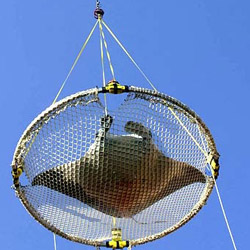
Clown fish (Sub Family of Amphiprioninae) can be found throughout the entire area of the Pacific Ocean. They are a tropical fish thus they reside only in the warmer waters of the Pacific Ocean. Clown fish have a symboitic relationship with another coral known as the anemone. But clown fish can also host in other corals such as toadstools, xenias, zoanthids, or even large polyp stony corals and even your powerhead in your aquarium. Once they determine their territory, they will defend it and chase other fish around and even your hands if it gets too closed. Most fish hobbyist prefer to give their clown fish an anemone host. Despite popular beliefs, clown fish do not need an anemone to thrive. In the wild, the clown fish uses the anemone as protection against other predators and the anemone benefits from scraps of food the clown fish will feed it. Due to their size and lack of speed, the clown fish has developed this relationship with an anemone. The more popular species are the percula or ocellaris. Most fish hobbyist have a hard time determining which one is which as they look almost identical to each other. Clownfish popularity also heighten with the release of Disney’s and Pixar’s movie “Finding Nemo”. Size: Clown fish size can range from 2-3″ to even bigger for some species. The more common species such as the percula and ocellaris (think Finding Nemo) usually range from the 2-3″ while other species such as Clarkii or the Maroon can get up to 4-5″ or bigger. Type of Fish: Clown fish are a great community fish. Despite being territorial, they get along with many other common saltwater community fishes. Another benefit of their behavior is that they do not need a large tank such as the yellow tang or others so alot of fish hobbyist can keep them in different size tanks. The general rule is to keep only 2 per tank but if you have a larger tank, you can try with more. They form a ranking system with the largest being the female and the next in line is male.
You need a few simple fish aquarium items to set up a thriving community for your clown fishes. First you need to pick an appropriate fish tank size. Try to get as big of a fish tank as you can get (everyone will tell you that you’ll always end up upgrading anyways). The next important thing you need is to pick a proper size filter. There are many different brands of filters to pick from but the rule of thumb is to get as big of a filter as you can get. Your aquarium filter system is very essential to the stability and growth of your fish tank. Since clown fish are a saltwater fish, I would also recommend that you invest in a really good protein skimmer to keep your water clean. Another important part is the proper aquarium lighting system. Depending on if you want to keep what types of corals, you can go with regular light bulbs or go as complex as metal halides for harder to keep anemones for hosting your clown fish. Your aquarium lighting system will also help bring out the vibrant colors of your fishes so it’s a good idea to invest in a good system. What to Feed Clown Fishes? Clown fishes accept most any type of food that will fit in their mouths. Most clown fishes that are available at pet stores are usually bred at fish farms and are fed basically what you can find at your local fish store. I personally feed mine with flake food that are made especially for small fishes like the clown fish in mind. Make sure you feed enough as it’s hard to determine which one has eaten do to their quickness and quantity. Once in awhile, I’ll also feed with mysis shrimp. What Conditions: Clown fishes are a tropical area fish. They prefer temperatures between 76F-82F so they can co-exist with many other saltwater tropical fishes. They easily adapt to any lighting although brighter bulbs brings out the shine of their colors better. Water clarity should be clear and clean with weekly water changes if possible. Editor’s Remarks: The clown fish is a great fish to add. Every tank I’ve had has always had a pair of clownfish in them. They are a great starter fish for beginners and a great fish for even the advanced fish keepers. HIGHLY RECOMMENDED! |





{ 6 comments… read them below or add one }
I think that it is also worth commenting that if you add 2 clown fish to an aquarium they will pair and one of the will turn into a female – normally the larger one.
Clown fish to me are the appitimy of reef fish, the way they waddle when they swim, the colours and the interaction they have with corals in the aquarium – an absolute how to watch and maintain.
You should have actual speed and life span (eg. 7mph, 4years) – not actual speed or life span. yoyoyoyoyoy ur website still rocks!
You might also add that the clown fish is part of the Damselfish family. It’s actually a damsel itself. The clown and the damsel are also the only two fish that do not get stung by anemone’s.
Thought I’d check into life span of clown fish, as I’ve had 2 since 1985. From what I have found…Scarface and Shashimi should be in the Guiness book of world records. They are 23 years old, and still going strong.
I have been breeding clownfish in my home aquarium for over a year. It is not that hard to do and can pay for the aquarium electricity bill. Not to meantion that you are doing the right thing by helping the hobby and protecting the reefs of the world.
How do you breed Clownfish?!